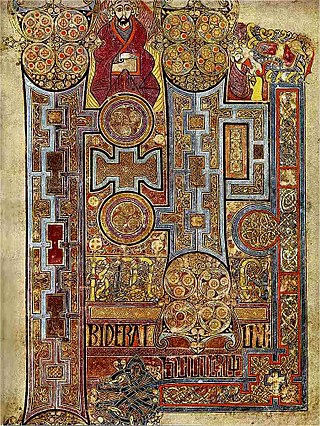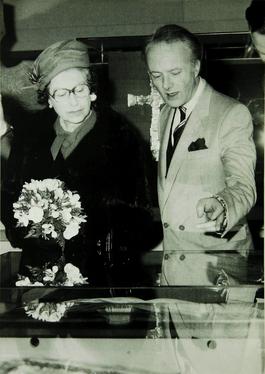External links
- Henry Bradshaw Society's website, where all volumes are listed.
| Founded | 1890 |
|---|---|
| Country of origin | United Kingdom |
| Headquarters location | London |
| Distribution | Boydell & Brewer |
| Publication types | Books |
| Nonfiction topics | rare liturgical texts |
| Official website | henrybradshawsociety |
The Henry Bradshaw Society is a British-based text publication society founded in 1890 for the scholarly editing and publication of rare liturgical texts.
An initial meeting to plan the Henry Bradshaw Society took place in London on 3 July 1890, after which provisional subscriptions were solicited. The general meeting to inaugurate the Society took place on 25 November 1890 in the Jerusalem Chamber at Westminster Abbey. A committee was finalised and a programme of publications worked out.
One of the models for the society was the Durham-based Surtees Society, formed in 1834, which in turn received assistance from officers of the Bannatyne Club. The foundation of the new society was also linked, more by overlapping interests than organizational models, to the body then known as the St Paul's Ecclesiological Society. John Wickham Legg, who had played a significant role in the re-establishment of that society in 1879 after a decade or so of limbo, also became an important founding member of the Henry Bradshaw Society.
The Society was named after Henry Bradshaw (1831–1886), Librarian of the Cambridge University Library, who had been interested in early printing and in bibliographic description. This latter passion led to his becoming familiar with many European libraries, where he also became aware of holdings of early English liturgical manuscripts.
The promised subscribers including many Anglican bishops and other dignitaries, but also Léopold Delisle of the Bibliothèque nationale, Paris, Antonio Maria Ceriani of the Ambrosian Library, Milan and others Catholics such as W.H. James Weale, Edmund Bishop, Dom Aidan Gasquet, the abbé Louis Duchesne, and Dom Hildebrand de Hemptinne, abbot of Maredsous. The first volumes were to be printed in 500 copies and at the next meeting the Council fixed the individual subscription rate as 12 guineas (£12 12s).
By the end of the 19th century some 19 volumes had been issued, three of which contained an edition of the Westminster Missal , given to the abbey by Abbot Nicholas Lytlington, abbot 1362–1386, and builder of the Jerusalem Chamber, where the Society was publicly launched.
Other early editions were of the coronation rites of King Charles I (1892), the Martiloge in Englysshe (1893), the Antiphonary of Bangor (1893–96; from the Ambrosian Library), the Tracts of Clement Maydeston (1894), the Winchester Troper , the Martyrology of Gorman (1895; from the Royal Library, Brussels), the Missal of Robert of Jumièges (1896; from Rouen public library), the Irish Liber Hymnorum (1898; from Trinity College Library, Dublin), the Rosslyn Missal (1899; from the Advocates Library, Edinburgh), the Coronation Book of Charles V of France (1899; British Library, Cotton Tiberius MS B.VIII), the Missale Romanum, printed in Milan in 1474 (1899–1907) and the fifteenth-century Processional of the Nuns of Chester (1899).
Although the Society fell into something of a slump after the Second World War, it was revived with some vigour in the 1980s. The latest volume to be published, in 2019, is numbered 124.
The Society's principal honorary officers currently include:

A Gospel Book, Evangelion, or Book of the Gospels, is a codex or bound volume containing one or more of the four Gospels of the Christian New Testament – normally all four – centering on the life of Jesus of Nazareth and the roots of the Christian faith. The term is also used for a liturgical book, also called the Evangeliary, from which are read the portions of the Gospels used in the Mass and other services, arranged according to the order of the liturgical calendar.

The Ambrosian Rite is a Latin liturgical rite of the Catholic Church. The rite is named after Saint Ambrose, a bishop of Milan in the fourth century. It is used by around five million Catholics in the greater part of the Archdiocese of Milan, in some parishes of the Diocese of Como, Bergamo, Novara, Lodi, and in the Diocese of Lugano, Canton of Ticino, Switzerland.

Lesnes Abbey is a former abbey, now ruined, in Abbey Wood, in the London Borough of Bexley, southeast London, England. It is a scheduled monument, and the abbey's ruins are listed at Grade II by Historic England.

Boy bishop or Chorister Bishop is the title of a tradition in the Middle Ages, whereby a boy was chosen, for example, among cathedral choristers, to parody the adult bishop, commonly on the feast of Holy Innocents on 28 December. This tradition links with others, such as the Feast of Fools and the Feast of Asses.
The Gallican Rite is a historical form of Christian liturgy and other ritual practices in Western Christianity. It is not a single liturgical rite but rather several Latin liturgical rites that developed within the Latin Church, which comprised the majority use of most of Western Christianity for the greater part of the 1st millennium AD. The rites first developed in the early centuries as the Syriac-Greek rites of Jerusalem and Antioch and were first translated into Latin in various parts of the Western Roman Empire Praetorian prefecture of Gaul. By the 5th century, it was well established in the Roman civil diocese of Gaul, which had a few early centers of Christianity in the south. Ireland is also known to have had a form of this Gallican Liturgy mixed with Celtic customs.

Saint Michael's Abbey is a Benedictine abbey in Farnborough, Hampshire, England. The small community is known for its liturgy, its pipe organ, and its liturgical publishing and printing. This abbey is also known for enshrining a Pontifically crowned image of Saint Joseph.

The term "Celtic Rite" is applied to the various liturgical rites used in Celtic Christianity in Britain, Ireland and Brittany and the monasteries founded by St. Columbanus and Saint Catald in France, Germany, Switzerland, and Italy during the early middle ages. The term is not meant to imply homogeneity; instead it is used to describe a diverse range of liturgical practices united by lineage and geography.
John Wickham Legg was an English physician who published on medical subjects, liturgy and ecclesiology.

Beuron Archabbey is a major house of the Benedictine Order located at Beuron in the upper Danube valley in Baden-Württemberg in Germany.

Latin liturgical rites, or Western liturgical rites, is a large family of liturgical rites and uses of public worship employed by the Latin Church, the largest particular church sui iuris of the Catholic Church, that originated in Europe where the Latin language once dominated. Its language is now known as Ecclesiastical Latin. The most used rite is the Roman Rite.

Gerard van Caloen (1853–1932) was a Belgian Benedictine liturgist, missionary, monastic founder, abbot, and bishop. He was rector of the abbey school at Maredsous, where in 1882 he published the Missel des Fidèles, the first French-Latin missal. He also introduced British-style association football to the school. In 1886, he was professor of liturgy at the College of Sant'Anselmo in Rome.

Bobbio Abbey is a monastery founded by Irish Saint Columbanus in 614, around which later grew up the town of Bobbio, in the province of Piacenza, Emilia-Romagna, Italy. It is dedicated to Saint Columbanus. It was famous as a centre of resistance to Arianism and as one of the greatest libraries in the Middle Ages. The abbey was dissolved under the French administration in 1803, although many of the buildings remain in other uses.

Prosper Louis Pascal Guéranger was a French priest and Benedictine monk, who served for nearly 40 years as the abbot of the monastery of Solesmes. Through the new Abbey of Solesmes, he became the founder of the French Benedictine Congregation, which re-established Benedictine monastic life in France after it had been wiped out by the French Revolution. Guéranger was the author of The Liturgical Year, a popular commentary which covers every day of the Catholic Church's liturgical cycles in 15 volumes. He was well regarded by Pope Pius IX, and was a proponent of the dogmas of the Immaculate Conception and of papal infallibility.
The Durham Rite is a historical liturgical use of the Roman Rite and the Gallican Rite in the English bishopric of Durham.
Cuthbert Johnson was a British Catholic priest, musician, liturgist and a Benedictine monk. He was the fourth Abbot of Quarr Abbey.
Dom André Wilmart O.S.B. was a French Benedictine medievalist and liturgist, who spent most of his career at St Michael's Abbey, Farnborough. He was a leading expert on medieval spirituality in the decades between the World Wars. He studied at the University of Paris and the seminary of Saint-Sulpice at Issy. After an extended stay at the Abbey of Solesmes, he decided to become a monk, making his profession in 1901. Shortly after he entered Solesmes, the monks left for England due to ongoing conflict between the Catholic Church and the government of the Third Republic. Wilmart was ordained as a priest in 1906. Soon afterwards he was sent to Farnborough, which was his home for the rest of his life. In addition to Wilmart's work as a scholar, he knew and was influenced by Catholic public intellectuals such as Charles Péguy and Baron von Hügel.

Fernand Cabrol was a French theologian, Benedictine monk and respected expert on the history of Christian worship.
The Bobbio Missal is a seventh-century Christian liturgical codex that probably originated in France.

Derek Howard Turner was an English museum curator and art historian who specialised in liturgical studies and illuminated manuscripts. He worked at the British Museum and the British Library from 1956 until his death, focusing on exhibitions, scholarship, and loans.

The Litlyngton Missal, also called the Westminster Missal, is an illuminated manuscript commissioned by Abbot Nicholas Litlyngton in 1383–1384 and donated by him to his monastery, Westminster Abbey, where it has remained ever since. It is a Catholic missal with text in Latin.